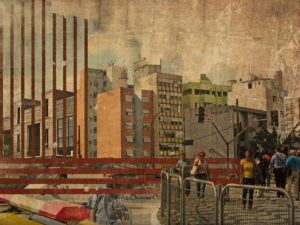 First encounter: I am seven. We are driving through downtown East Peoria, the small city in Central Illinois where I grew up, me and my mom in the front, my younger sister in the back. Summer. Windows down. Congested traffic. The heat bakes the concrete. Ahead there is a commotion. Shouting, cars honking, more shouting. In the strip mall on the right a group of people have gathered, one or two dozen, all of them white like us. They wave red flags with black symbols, thrust their arms into the air, chant Sieg heil! Some people in other cars yell at the group, spit out their windows. We catch every red light. I watch, afraid, even though I don’t fully understand what’s going on. We inch closer and our mom snaps at us to roll up the windows.
First encounter: I am seven. We are driving through downtown East Peoria, the small city in Central Illinois where I grew up, me and my mom in the front, my younger sister in the back. Summer. Windows down. Congested traffic. The heat bakes the concrete. Ahead there is a commotion. Shouting, cars honking, more shouting. In the strip mall on the right a group of people have gathered, one or two dozen, all of them white like us. They wave red flags with black symbols, thrust their arms into the air, chant Sieg heil! Some people in other cars yell at the group, spit out their windows. We catch every red light. I watch, afraid, even though I don’t fully understand what’s going on. We inch closer and our mom snaps at us to roll up the windows.
*
If I asked questions I don’t remember the answers. At some point I came across his name—Matt Hale, leader of the locally-based white supremacist group—and saw his picture in the paper. His presence and his message, once I was aware of it, wove its way through my childhood, even if its imprint has only revealed itself retroactively.
There was the time in second grade when our teacher told us that a black kid—the only one I’d ever been in class with—was to join us, and we had to be nice to him because he was different. Or how our elderly neighbor—who went to our church—said that “those niggers in Peoria are no better than animals.” Or the time when, shopping for school supplies, my mom and I were stopped by a man distributing anti-Jewish pamphlets (Save the white race! they proclaimed). Or how the poor white kids who played basketball, listened to Tupac, sagged their pants, and drawled their speech were wiggers—different from the poor white kids who wore oversized T-shirts logoed with rock and metal bands. Or or or or.
*
In a high school history class, we learn about the Holocaust, watch part of Schindler’s List. Somebody asks our teacher about Matt Hale, who was a student of his. That’s how it was: every conversation about ethnic minorities or racial injustice had to be measured against Hale’s white supremacist rhetoric. We want to know: what was he like? What we really wanted to know: how much like him are we?
*
Early 00s: We are a group of teenagers cramped around a computer in one of our parents’ basement. Somebody has gotten hold of Matt Hale’s instant messenger name. We bring it up on the computer, fire off a message. Hi. He responds. Hello. We start off slow, ask him about the violin. (He plays the violin.) He tells us his favorite classical piece. We chat about practice habits. Then we drop, in our minds, the bomb: So, how come you hate Jews and black people?
Make no mistake: we were not activists. We were, primarily, in it for the thrill and the self-congratulations of trolling a radical white supremacist, so that every time we joked about the ghettos in South Peoria, or said that we were Jewed out of something, or rapped niggas along with songs blasting from our car stereos, we could do so with a clear conscience, because the viral racism that infected people like Matt Hale had not spread to us.
We settle into our chairs, waiting. Seconds pass, a full minute. Nothing happens.
*
In 2003 Matt Hale is arrested and later sentenced to 40 years in prison for soliciting the assassination of a judge. Relief passes through the community. He’s gone. It’s over.
I, too, am guilty of this line of thinking. I leave for eight years, go to grad school in Southeast Ohio and Nebraska. While I’m gone, I miss it. It’s home. The bad parts fade; I romanticize it, the particular way the wind blows through a cornfield, the way storms roll in on the horizon, and so on.
Then I graduate, get a job, and my wife and I move back. Shortly after we move in, we hear a commotion outside. Two young white boys tromp through our yard into the meadow behind our rented house, which is filled with rusted trucks and old construction equipment. Their truck is parked out front: oversized, dusty white, a large Confederate flag dangling from the back window, blazing in the sunlight.
__

3 comments
Leiana Hilton says:
Sep 12, 2016
Amazing how you remember an event from so long ago, and I (as you mother) just wanted to protect you from the hatred of the world. This was a very moving and powerful story, beautifully written!
Nicole Moliere says:
Sep 13, 2016
Great piece. Thank you.
Lesslie says:
Sep 14, 2016
I agree. I can’t believe you remember so many things in detail at that age. This piece is beautifully written, I wish it could go on and on. There is so much behind the words that i want to hear. You are a great writer, give me more.